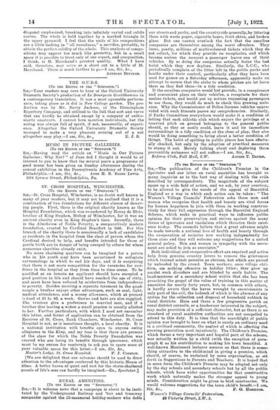JEAN MARCHAND.
(To THE EDITOR Of THE " SPECTATOR."] SIR,—May I draw your attention to the exhibition of M. Marchand's work at the Independent Gallery, 7A Grafton Street, which I believe to be one of the most important one-man shows that there have ever been? M. Marchand is a great modern artist. He employs natural forms, but the illustrative element in his work is admirably subordinated to the higher and more signifiCant aesthetic qualities. He does what abstract art splendidly aims at but rarely achieves, what all true artists have achieved but rarely aimed at. He feels the intellectual in art emotionally, and expresses it artistically. His compositions are intricate and original, and profoundly satisfying in their unity. " La Maternite," for example, consists of a close " bundle " of unending rhythmical curves in three dimensions supported by a heavy rectilinear background. Among the many exquisite movements, one going into the picture from the top of the mother's head, descending by her upper arm and coming forward again by her forearm and the baby's leg, is particularly attractive. I can only compare these rhythms to Rubens's. No. 16, again, shows a curvilinear system imposed on a rectangular. But his usual interest is in rigid construction, for which he frequently employs terraces or viaducts, or the hard lines of buildings. In " St. Paul " (No. 24), a townscape, one of the most daring and original of his works, the compo- sition is primarily of two pyramids. A strong vertical form in the left foreground meets a horizontal at the bottom in the same plane, and picks up, at the point of junction, a diagonal line running through the picture plane. This diagonal forms a side of one of the pyramids. The vertical form is drawn aside slightly to answer the diagonal line in the picture plane which forms a side of the other pyramid. There is a horizontal feeling at the top background which, with the sky, answers the one at the bottom foreground and gives weight to the picture. This is only an outline analysis of the composition, whose complex subtlety and balance cannot lie grasped without a close examina- tion, but some idea of its rigidity may have been conveyed. There is in all his work an admirable union of colour with form, and a feeling for colour values as sure as his feeling for spaces. In No. 7, " Mistral an Printemps," he has again used a vertical form on the left, but for a different purpose; it serves to throw the rest of the picture into rescession and at the same time to link it to the spectator. " La Cascade (No.. 5) is com- posed of two pyramids arranged like an hour-glass, with one
diagonal emphasized, breaking into infinitely varied and subtle curves. The whole is held together by a marked triangle in the upper pyramid. I feel that the units of his compositions are a little lacking in " all roundness," a sacrifice, probably, to obtain the perfect solidity of the whole. This analysis of compo- sitions may appear too much like geometry, but in a small space it is possible to treat only of one aspect, and composition, I think, is M. Marchand's greatest quality. What I have said, therefore, may serve as a short cut to a little of M. Marchand. There is much farther to go.—I am, Sir, &c.,
ANTHONY BERTRAM'.











































 Previous page
Previous page